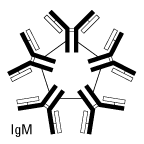Search
Immunoglobulin IgM Class
Serum IgM exists as a pentamer in mammals and comprises approximately 10% of normal human serum Ig content. It predominates in primary immune responses to most antigens and is the most efficient complement-fixing immunoglobulin. IgM is also expressed on the plasma membrane of B-lymphocytes as a monomer. In this form, it is a B-cell antigen receptor, with the H-chains each containing an additional hydrophobic domain for anchoring in the membrane. Monomers of serum IgM are bound together by disulfide bonds and a joining (J) chain.
Each of the five monomers within the pentamer structure is composed of two light chains (either kappa or lambda) and two heavy chains. Unlike in IgG (and the generalized structure shown above), the heavy chain in IgM monomers is composed of one variable and four constant regions, with the additional constant domain replacing the hinge region. IgM can recognize epitopes on invading microorganisms, leading to cell agglutination. This antibody-antigen immune complex is then destroyed by complement-fixation or receptor-mediated endocytosis by macrophages. IgM is the first immunoglobulin class to be synthesized by the neonate and plays a role in the pathogenesis of some auto-immune diseases.

Properties of IgM:
- Molecular weight: 900,000
- H-chain type (MW): mu (65,000)
- Serum concentration: 0.5 to 2 mg/mL
- Percent of total immunoglobulin: 10%
- Glycosylation (by weight): 12%
- Distribution: mostly intravascular
- Function: primary response
Immunoglobulin M (IgM) is the third most common serum Ig and takes one of two forms:
- a pentamer where all heavy chains are identical and all light chains are identical
- a monomer (e.g., found on B-lymphocytes as B-cell receptors)
The large pentameric structure allows for building of bridges between encountered epitopes on molecules that are too distant as to be connected by smaller IgG antibodies.
IgM is the first antibody built during an immune response. It is responsible for agglutination and cyto-lytic reactions since in theory, its pentameric structure gives it 10 free antigen-binding sites as well as it possesses a high avidity. Due to conformational constraints among the 10 Fab portions, IgM only has a valence of 5. Additionally, IgM is not as versatile as IgG. However, it is of vital importance in complement activation and agglutination.
IgM is predominantly found in the lymph fluid and blood and is a very effective neutralizing agent in the early stages of disease. Elevated levels can be a sign of recent infection or exposure to antigen.
Related content
For Research Use Only. Not for use in diagnostic procedures.
For Research Use Only. Not for use in diagnostic procedures.